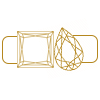Diamond Grading: The Secrets Behind 4cs of Diamond

Are you wondering how diamonds are evaluated and what factors influence their value? Understanding diamond grading is essential for making an informed purchasing decision. Diamonds aren’t just stunning and rare, they’re valuable investments that can last a lifetime. But how do professionals determine their worth? In this comprehensive guide, we’ll break down the process of diamond grading, focusing on the Four Cs, Cut, Color, Clarity, and Carat, so you can fully appreciate what makes each diamond special.
What is Diamond Grading and How It Impacts Value?
Diamond grading refers to the process by which diamonds are evaluated to assess their quality. While diamonds have been valued for centuries, the modern grading system was only established in the early 1900s. Before this, diamonds were categorized subjectively by traders and jewelers as "flawless" or "perfect," but these terms lacked consistency and standardization.
In 1939, the Gemological Institute of America (GIA) introduced the Four Cs: Cut, Color, Clarity, and Carat weight, creating a universally recognized grading system that remains in use today. These four parameters allow jewelers, investors, and consumers to understand exactly what they’re paying for and make informed decisions when buying diamonds.
Why Diamond Grading is Important for Your Jewelry Investment
Diamond grading is essential for ensuring quality, value, and authenticity in the diamond market. Accredited grading organizations, such as the Gemological Institute of America (GIA) or the International Gemological Institute (IGI), assess diamonds based on the standardized 4Cs—Carat weight, Cut, Color, and Clarity. This consistency builds consumer confidence by offering a certified evaluation of the diamond's quality, reducing the risk of fraud or misrepresentation.
Grading also upholds market integrity by providing transparency and promoting ethical business practices. It helps determine a diamond's market value, influencing resale prices and investment decisions. Additionally, accurate grading protects buyers from counterfeits and synthetic diamonds, ensuring they receive the expected quality. Technological advancements in grading tools have improved precision, leading to more reliable evaluations and further boosting trust in the process.
Understanding the 4Cs of Diamond Grading: A Key to Quality

Just as an interviewer looks for specific qualities and traits in candidates before hiring them, a diamond grader evaluates a diamond using the Four Cs to determine whether it is real or fake. If the diamond is authentic, the grader then assesses its quality. Let's explore each of the Four Cs in detail, one by one, in chronological order to understand how they contribute to determining a diamond's value.
First C of 4Cs: The Cut
The cut of a diamond is the most important factor, as it determines the brilliance and sparkle of the stone, significantly affecting its overall appearance. According to the Gemological Institute of America (GIA), a diamond's cut is graded on a scale ranging from excellent to poor. The higher the cut grade, the more valuable the diamond will be. The cut is a technical aspect that governs how light interacts within the diamond, creating its signature sparkle.
Second C of 4Cs: The Color
Color is the second most important factor in determining a diamond’s quality. While a diamond’s luster and sparkle are essential, color plays a crucial role as well. Diamonds come in a range of colors, from colorless to yellowish and brownish hues. The purest and most valuable diamonds are completely colorless. As the color shifts from colorless to yellow and then to brown, the quality and price of the diamond decrease. To help categorise diamonds based on their color, the Gemological Institute of America (GIA) developed a color chart that assigns a specific grade to each hue.
Third C of 4Cs: The Clarity
Clarity is the factor used to determine how pure a diamond is. Believe it or not, clarity is one of the most challenging aspects of diamond grading. As diamonds form deep within the earth, they often contain impurities, known as inclusions, which can significantly impact their overall quality. The most valuable diamonds are those without any impurities, classified as "internally flawless." As the number and size of inclusions increase, the quality and value of the diamond decrease.
Fourth C of 4Cs: The Carat
Last but not least, the weight of a diamond is one of the most common factors used to determine its value. Just as human weight is measured in kilograms or pounds, the weight of a diamond is measured in carats. One carat is equal to 0.2 grams, so a diamond weighing 1 gram is equivalent to 5 carats.
How Diamonds Are Graded: The Process Behind Diamond Evaluation
The diamond grading process involves a detailed evaluation of a diamond's quality based on the 4Cs: Carat weight, Cut, Color, and Clarity. Here’s how diamonds are graded step-by-step:
Submission and Initial Inspection
Diamonds are sent to accredited laboratories like the Gemological Institute of America (GIA) or the International Gemological Institute (IGI). Upon arrival, they undergo an inspection to check for any surface dirt or damage, which is then cleaned to ensure accurate grading.
Carat Weight Measurement
Using an electronic balance, the diamond is weighed to determine its carat weight. This is a key factor in establishing its value, as carat weight directly impacts the price.
Dimensional Measurements
Advanced optical tools are used to measure the diamond's proportions and facet angles. This data helps evaluate the diamond’s overall shape, symmetry, and structure.
Clarity Assessment
Under 10x magnification, trained gemologists examine the diamond for any internal inclusions or external blemishes. The findings are documented on a clarity plot, showing the size, position, and nature of each imperfection. Multiple graders assess the clarity, and if there are disagreements, a senior gemologist may make the final determination.
Color Grading
The diamond’s color is compared to a set of master stones that represent different grades, from D (colorless) to Z (light yellow or brown). Grading is performed in a controlled environment to ensure accuracy, free from external lighting influences.
Cut Evaluation
The final grading step evaluates the cut, which affects the diamond's sparkle and brilliance. Factors like brightness, fire (dispersion of light), scintillation (sparkle), proportions, polish, and symmetry are carefully assessed.
Final Review and Certification
Once all evaluations are complete, the diamond’s grading information is compiled into a report, including details on the 4Cs. This report may also include security features like holograms or micro-printing to prevent counterfeiting. For added security, diamonds can be laser-inscribed with their certification number, making them identifiable.
Diamond Cut Grading: How It Affects Sparkle and Value

The diamond cut plays a crucial role in determining its overall quality and visual appeal. It directly affects the diamond's brilliance and sparkle, making it one of the most vital elements in the 4Cs of diamond grading. Below is an overview of how diamond cut quality is assessed, with a focus on the GIA (Gemological Institute of America) grading system.
Key Factors That Determine Diamond Cut Quality
- Brightness: Refers to the amount of white light the diamond reflects. A well-cut diamond displays high brightness, enhancing its visual charm.
- Fire: The dispersion of light into colors, with diamonds that show vibrant flashes of color having strong fire.
- Scintillation: The sparkle and pattern of light and dark areas seen when the diamond is moved. A finely cut diamond will have excellent scintillation.
- Weight Ratio: This compares the diamond’s weight to its dimensions, influencing how effectively it reflects light.
- Durability: A diamond's durability depends on its proportions and polish, which impact its wear resistance and longevity.
- Polish: Assesses the smoothness of the diamond's surface post-cutting. A high-quality polish reduces surface imperfections and enhances the diamond's brilliance.
- Symmetry: Examines the alignment and balance of the diamond's facets. Well-executed symmetry enhances light reflection and elevates the overall visual appeal.
Essential Tools Used for Accurate Diamond Cut Grading
- Loupe 10x and Other Scopes
- Microscope
- Grading Chart
- Sarine Systems
- Facetware Software
- Heathcoat’s optical bench
- Polish and Symmetry Evaluation Tools
- Crown and Pavilion Gauges
Understanding the GIA Diamond Cut Grade Scales
|
Grade |
Description |
|
Excellent |
The diamond reflects nearly all the light that enters, creating maximum brilliance. The proportions and symmetry are near perfect. |
|
Very Good |
The diamond reflects most of the light that enters, producing high brilliance, but there may be slight imperfections in proportion or symmetry. |
|
Good |
The diamond reflects a fair amount of light, but some brilliance may be lost due to minor issues in proportion or symmetry. |
|
Fair |
The diamond has noticeable flaws in proportion or symmetry that reduce its brilliance. Light performance is significantly compromised. |
|
Poor |
The diamond has major proportion and symmetry issues, which cause it to lose most of its brilliance and sparkle. |
Diamond Color Grading: Why Colorless Diamonds Are More Valuable

Diamond color grading evaluates the presence of color in a diamond, with the most valuable diamonds being completely colorless. The Gemological Institute of America (GIA) developed a color grading scale to assess diamonds, ranging from D (colorless) to Z (light yellow or brown).
Advanced Tools for Accurate Diamond Color Grading
- Diamond Color Comparison Tray
- GIA Color Grading Chart
- LED Color Grading Light
- Color Grading Viewer
- Diamond Color Grading Master Set
The Diamond Color Grading Scale: From D to Z Explained
|
Grade |
Description |
|
D |
Colorless – No color visible. The highest grade. |
|
E |
Colorless – Slight traces of color, only detectable by an expert. |
|
F |
Colorless – Minor traces of color, still considered excellent quality. |
|
G |
Near Colorless – A very faint trace of color, barely noticeable to the untrained eye. |
|
H |
Near Colorless – Slight color visible, but still a high-quality diamond. |
|
I |
Fair – Noticeable color, but still appealing. |
|
J |
Fair – Slightly more noticeable color, but still within acceptable standards for many buyers. |
|
K |
Light Yellow – Noticeable yellow or brown hue. |
|
L |
Light Yellow – More intense yellow or brown color. |
|
M-Z |
Faint to Light Yellow/Brown – Noticeably colored diamonds, less valuable. |
Diamond Clarity Grading: Understanding the Visual Purity of Diamonds

Diamond clarity grading plays a crucial role in evaluating a diamond's quality and value. It involves examining both internal imperfections, called inclusions, and external flaws, known as blemishes. The Gemological Institute of America (GIA) uses a widely recognized clarity scale, ranging from Flawless (FL) to Included (I3). This system assesses the clarity of a diamond, considers various influencing factors, and helps consumers understand how clarity impacts their purchase decision.
The Different Diamond Clarity Grades Explained
- Flawless (FL): No visible imperfections.
- Internally Flawless (IF): No internal imperfections but may have minor surface blemishes.
- Very, Very Slightly Included (VVS1, VVS2): Inclusions are difficult to detect.
- Very Slightly Included (VS1, VS2): Inclusions visible under magnification but not the naked eye.
- Slightly Included (SI1, SI2): Inclusions visible under magnification and sometimes to the naked eye.
- Included (I1, I2, I3): Obvious inclusions visible to the naked eye.
Key Factors That Influence Diamond Clarity and Value
- Size: Larger inclusions have a greater effect on the clarity grade than smaller ones, with bigger flaws lowering the grade.
- Number: The total count of inclusions can also impact the grade. More inclusions, even if small, can result in a lower clarity score than fewer, larger inclusions.
- Type: The kind of inclusion (such as feathers or crystals) affects both the diamond's durability and visual appeal.
- Location: Where the inclusions are located matters. Flaws near the center or table of the diamond are more noticeable than those near the edges or pavilion.
- Relief: This measures how easily an inclusion can be seen against the diamond's background. Darker inclusions tend to be more visible than lighter ones.
How Carat Weight Affects Diamond Size and Value

Carat is measured by weighing the diamond in metric carats. Each carat is exactly 200 milligrams or 0.2 grams. Now, the term for carat comes from the carob seed. Historically, it was used as a reference standard for weighing gemstones because of its uniform size. Today, modern digital scales weigh diamonds accurately to the hundredth - that is, to the 0.01 of a carat.
Diamond Grading vs. Gemstone Grading: What’s the Difference?
While both diamond grading and gemstone grading are evaluation processes of precious stones, each looks to focus on different issues due to the unique features of a diamond distinguishing it from other gemstones.
Grading Criteria:
Focuses on the 4Cs – Cut, Color, Clarity, and Carat Weight.
Focuses on factors such as Color, Clarity, Size, Shape, Transparency, and sometimes Origin.
Focus:
- Diamond Grading:
The Cut is the most critical factor, as it affects the diamond's brilliance and sparkle.
- Gemstone Grading:
More emphasis on Color and Clarity, but each gemstone has unique grading considerations (e.g., Sapphire color richness, Emerald inclusions).
Grading Systems:
- Diamond Grading:
Standardised grading scale (e.g., GIA scale: FL, IF, VVS, VS, SI, I).
- Gemstone Grading:
Varies across different types of gemstones, with different scales and criteria (e.g., rubies, sapphires, emeralds have distinct grading systems).
Appearance Focus:
- Diamond Grading:
Emphasizes the overall brilliance, fire, and sparkle based on the cut.
- Gemstone Grading:
Focuses on color intensity, clarity, and the overall appearance of the gemstone.
Conclusion
Grading of diamonds is the most important process to ascertain the actual worth and quality of a diamond. Upon analysis of the Four Cs: cut, color, clarity, and carat weight, gemologists obtain a true, standardised assessment in a transparent manner, which both the buyer and the seller know what they are paying for.
This grading system not only helps individuals make wise purchasing decisions but also aids in keeping the diamond industry honest. Whether you are a user or a collector, knowing about diamond grading gives you the opportunity to appreciate the detailed differences that separate each stone. With this knowledge, you can make a better choice as you choose a diamond that fits your expectation, knowing that its beauty and value are certified and accurate.
FAQs: Diamond Grading
Difference Between Flawless and VS Diamonds
Those diamonds classified as Flawless (FL) possess no inclusions or blemishes at a 10x magnification. They are, therefore, very rare and expensive. In contrast, diamonds with Very Slightly Included (VS) characteristics possess minor inclusions hard to view even at 10x magnification and are usually not visible by the naked eye.
What Are SI Clarity Diamonds?
SI clarity diamonds are those that contain inclusions visible under 10x magnification and sometimes to the bare eye, and more or less for SI2. SI diamonds tend to be quite popular since they will indeed give a high-quality appearance at an affordable price, thereby making diamonds very accessible to most customers.
How Does Diamond Color Influence Its Grade?
Color grading refers to the color of a diamond. A diamond is graded colorless, while from D to Z being light yellow or brown. Colorless diamonds are very valuable for the simple reason that without color, there is more room for the light to be reflected for brilliance. Even small color differences can be hugely important in terms of value; the most expensive ones tend to be the colorless diamonds.
What Does the Diamond Grading Report Include?
A diamond grading report, for instance, issued by the GIA or AGS, includes an assessment of a diamond's 4Cs: cut, color, clarity, and carat weight, plus many more details about proportions, polish, symmetry, and fluorescence. In fact, it is a quality and authenticity certificate.
GIA vs. AGS Grading-What's the Difference?
GIA uses an alphabetical scale (D-Z) for color and qualitative terms for clarity, whereas AGS uses a numerical system (0-10). AGS is particularly noted for having very detailed grading for cuts, which is why it is primarily in demand by the consumers, who are fussier about that cut. Both have very high credibility regarding grading diamonds.

 Accent Ring
Accent Ring
 Bridal Set
Bridal Set
 Halo Ring
Halo Ring
 Solitaire Ring
Solitaire Ring
 Vintage Ring
Vintage Ring
 Three Stone Ring
Three Stone Ring
 Brilliant Cut Ring
Brilliant Cut Ring
 Old Cut Ring
Old Cut Ring
 Rose Cut Ring
Rose Cut Ring
 Step Cut Ring
Step Cut Ring
 Portrait Cut Ring
Portrait Cut Ring
 Bezel Set
Bezel Set
 Channel Set
Channel Set
 Dainty Ring
Dainty Ring
 Eternity Band
Eternity Band
 Toi-Et-Moi Ring
Toi-Et-Moi Ring


 Studs
Studs
 Drop & Dangle
Drop & Dangle
 Hoop Earrings
Hoop Earrings
 Pendants
Pendants
 Necklaces
Necklaces
 Bracelets
Bracelets
 Bangles
Bangles
 Ring
Ring
 Bracelet
Bracelet


 2-3 Stone Ring
2-3 Stone Ring





![two emerald rings by goldenbird jewels, showcasing in sleek grey background, with jewelry box, [Text] Emerald ring style for 2025](http://www.goldenbirdjewels.com/cdn/shop/articles/10_Emerald_Ring_Styles_for_2025_Main_Banner_2048X1024_08ce3abe-68fd-4164-8e84-630ea85fe82c_1024x1024.webp?v=1735044302)

![Heart shaped ladiamond gripped in a twizzer, [TEXT]- Lab-Diamond Certification, [GIA], [IGI], [Goldenbird Jewels]](http://www.goldenbirdjewels.com/cdn/shop/articles/Lab_Diamond_Certifications_copy_1024x1024.webp?v=1734778441)


![High resolution image of the necklace of pesr shaped emerald stones wtoh smooth surface, hanging over black rock which is shinning from the top -[Text]- Emeralds, nature's green masterpiece-[Goldenbirdjewels]](http://www.goldenbirdjewels.com/cdn/shop/articles/banner_2_1024x1024.webp?v=1734775045)



